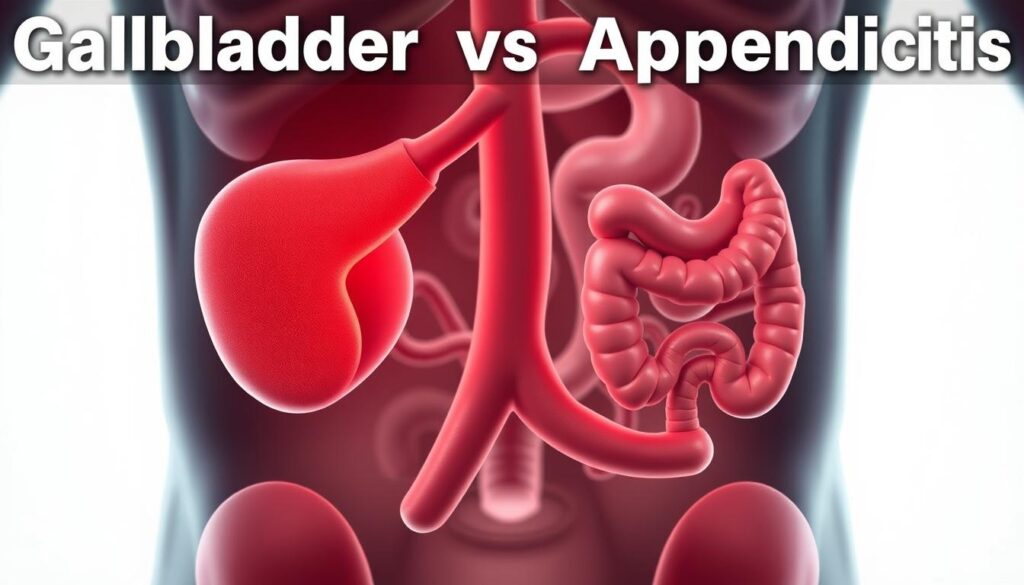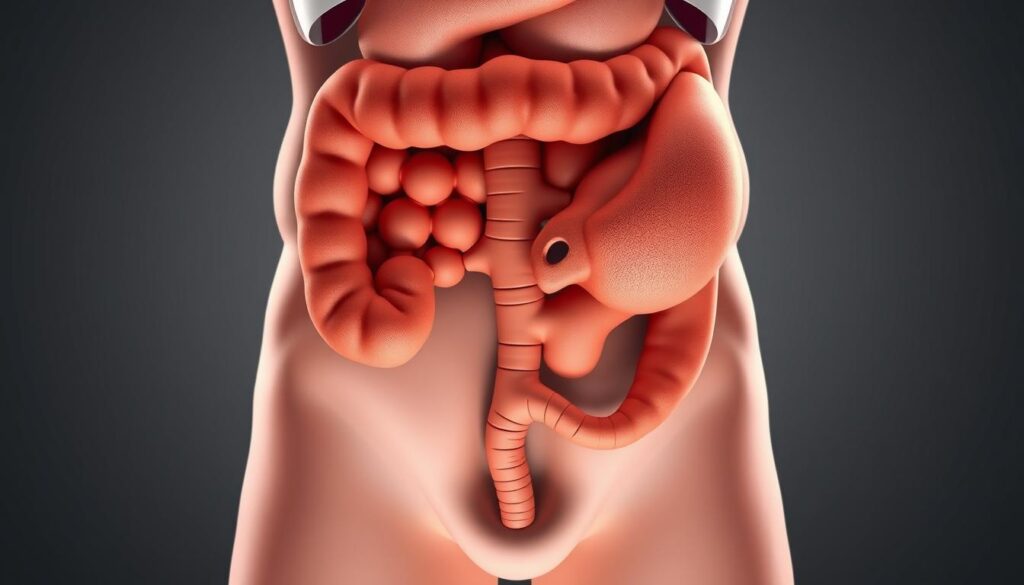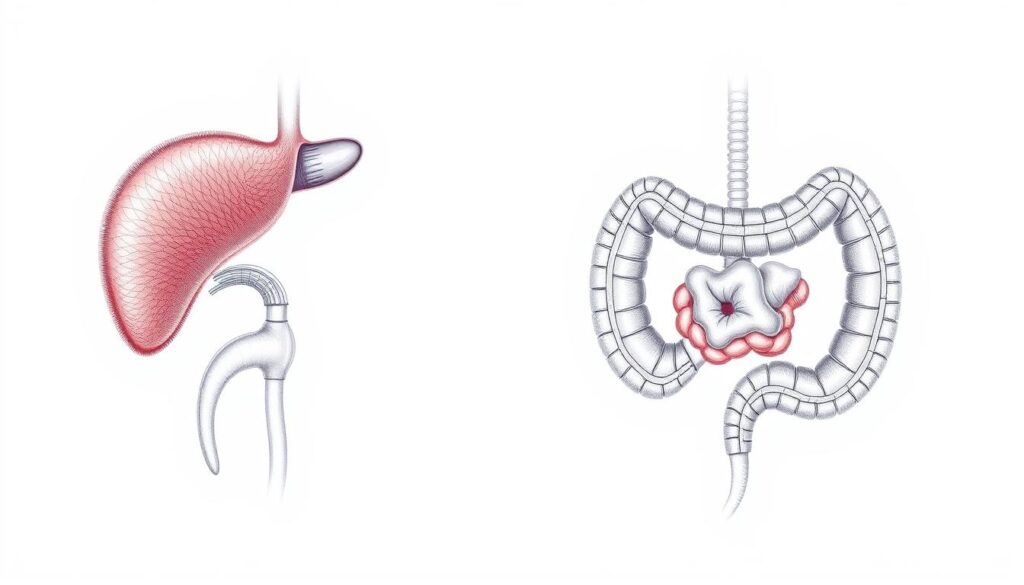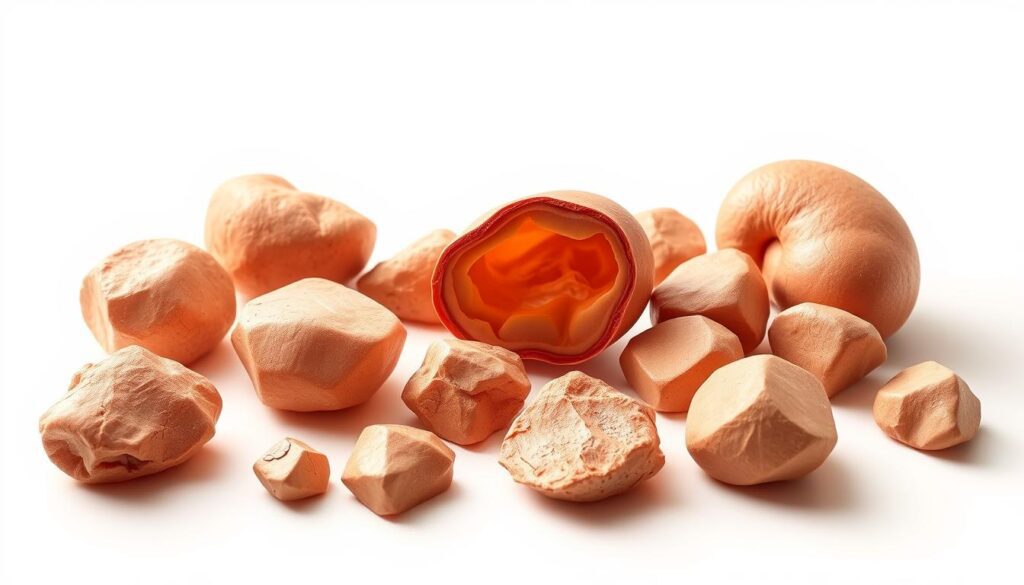Imagine a sharp ache in your belly, but you’re not sure if it’s your gallbladder or appendix. This is a common problem. Every year, thousands of people face this issue, unsure if they should ignore the pain or seek help.
Knowing the difference between gallbladder and appendix issues is key to your health. Both can cause a lot of pain, but their treatments and risks are different.
Understanding Gallbladder or Appendix Problems

Abdominal pain can mean many things, but knowing the difference between gallbladder and appendix issues is key. Both can cause pain in the belly, but they work differently. Getting the right diagnosis is important to treat the problem correctly.
The Importance of Proper Diagnosis
Getting a correct diagnosis is vital. For example, if you think you have appendicitis, you need to see a doctor right away. This is because it can burst if not treated quickly.
Gallbladder problems, like stones, need special care too. Doctors use scans and blood tests to figure out what’s wrong.
When to Seek Medical Attention
- Sudden severe pain in lower right abdomen may indicate appendicitis.
- High fever with vomiting demands immediate evaluation.
- Gallbladder symptoms like steady upper right pain after meals warrant prompt care.
Common Misconceptions About These Organs
Some people think you can’t get appendicitis without surgery, but that’s not true. Another myth is that the appendix doesn’t do anything, but research shows it might help fight off infections.
Can gallbladder problems affect the appendix? No, they work separately. Gallbladder issues can happen to anyone, not just older adults.
Anatomical Overview: Location and Function
First, let’s look at where these organs are and what they do. The gallbladder and appendix have their own spots and jobs in the belly. This part will clear up any confusion about where they are and why they matter?

Gallbladder Location and Purpose
The gallbladder is a small, pear-shaped organ. It’s found under the liver in the upper right part of the belly. It’s about 3-4 inches long and holds bile from the liver. Bile helps break down fats in our food. Even though it’s small, it plays a big role in how we absorb nutrients.
Appendix Location and Function
The appendix is a finger-shaped tube. It’s attached to the cecum, which is the start of the large intestine. It’s located in the lower right part of the belly. It used to be thought of as useless, but now we think it helps with gut bacteria and the immune system. It helps keep our digestive system healthy.
Is the Gallbladder Next to the Appendix?
Even though they’re both on the right side, they’re not right next to each other. The gallbladder is near the liver, and the appendix is lower, near the pelvis. They’re not close enough for pain in one to affect the other. Sometimes, their positions can change a bit, but they usually don’t touch.
What is More Important: Gallbladder or Appendix?
When we ask what is more important gallbladder or appendix, we need to look at their roles. The gallbladder stores bile to help digest food. The appendix helps with the immune system and keeps good bacteria in the gut. Neither organ is strictly needed to live, as the body can adapt without them.

After gallbladder removal, bile goes straight from the liver to the small intestine. This can lead to issues like diarrhea. But, many people find ways to manage their digestion with diet changes.
The appendix is small but important for the gut’s health after infections. Removing it doesn’t usually harm long-term health but might need medical care if it’s inflamed.
- Gallbladder: Key for fat digestion; removal requires bile flow adjustments.
- Appendix: Supports immune response; its absence doesn’t halt gut function entirely.
Gallbladder Conditions and Symptoms

Gallbladder stones, or cholelithiasis, form when cholesterol or bilirubin hardens. These gallbladder stones can block ducts, causing severe pain. Risk factors include the “4 Fs”: female gender, age over 40, multiple pregnancies, and obesity.
- Gallbladder symptoms of stones may include sudden upper abdominal pain, nausea, or bloating after fatty meals.
- Some people have “silent” stones with no symptoms until complications arise.
Gallbladder Stones: Causes and Symptoms
Cholesterol-based stones form when bile contains too much cholesterol or too little bile salts. Pigment stones develop from excess bilirubin, often in liver diseases. Symptoms like biliary colic—sharp, cramping pain in the upper right abdomen—are common. Severe cases may cause jaundice or fever.
Cholecystitis and Inflammation
Cholecystitis occurs when stones block bile flow, causing inflammation. Symptoms include persistent pain in the upper abdomen, fever, and vomiting. Prolonged blockages can lead to gangrene or infections requiring emergency care.
Recognizing Symptoms Across Groups
Older adults may show milder symptoms, delaying diagnosis. Women often report more frequent episodes than men. Ethnic groups with higher cholesterol levels, like Mexican Americans, face increased risk. Pregnant individuals may experience worsened symptoms due to hormonal changes.
Appendicitis: The 4 Stages and Warning Signs
Early Symptoms of Appendicitis
- Stage 1: Mild discomfort near the belly button
- Stage 2: Pain moves to lower right side as inflammation grows
- Stage 3: Severe pain with vomiting and rigid abdomen
- Stage 4: Ruptured appendix causing widespread pain
Appendix Symptoms in Females vs. Males
Women might feel pain that feels like menstrual cramps or ovarian issues. Pregnant people might feel pain higher up because of organ movement. Endometriosis can make it hard to tell if a woman has appendix symptoms.
How to Test for Appendicitis at Home?
There’s no home test that says for sure if you have appendicitis. But, you can try a few things:
- Pressing the lower right abdomen to detect tenderness
- Checking for rebound tenderness (pain when pressure is released)
Which Pain is Worse: Gallbladder or Appendix?
Figuring out which pain is worse gallbladder or appendix depends on the symptoms. Both conditions are very painful, but they have different patterns and triggers.
Pain Characteristics and Patterns
- Appendix pain starts off mild near the belly button and gets sharper in the lower right abdomen.
- Gallbladder pain can come and go, getting worse after eating fatty foods.
- Severe appendix cases can get worse fast, needing quick medical help.
Pain Location and Radiation
Appendix pain is mainly in the lower right abdomen. Gallbladder pain starts in the upper right and can spread to the back or right shoulder. Appendix pain usually stays in one area as it gets worse.
Associated Symptoms That Help Differentiate
- Fever is common with appendicitis but less so with mild gallstones.
- Nausea and vomiting happen in both, but gallbladder issues might also include indigestion or bloating.
- Severe appendix pain with high fever needs immediate medical check-up.
Treatment Options for Gallbladder Conditions
Treating gallbladder issues depends on symptoms and severity. Options range from medication to surgical intervention. Here’s a clear guide to each step:
Medication and Non-Surgical Approaches
For mild cases, doctors may suggest:
- Bile acid pills to dissolve gallbladder stones slowly
- Pain relievers to manage discomfort
- Lithotripsy to break stones with shock waves
Gallbladder Removal: Procedure and Recovery
Laparoscopic gallbladder surgery is common. Surgeons remove the organ through tiny incisions. Most patients go home within 24 hours. In complex cases, open surgery requires a larger cut and longer recovery. Recovery takes 1–2 weeks. Doctors advise light activity and pain management during this period.
Life After Gallbladder Surgery
After removal, bile flows directly to the intestine. Patients often adopt low-fat diets to avoid digestive issues. Common adjustments include:
- Avoiding fatty meals to prevent diarrhea
- Smaller, frequent meals for better digestion
Appendicitis Treatment and Surgery
Appendicitis needs quick care to avoid serious problems. The main treatment is removing the appendix through surgery. Now, doctors use laparoscopic methods, which are less invasive than old ways.
Laparoscopic surgery means small cuts in the belly. People usually stay in the hospital for 1-2 days. Doctors help manage pain with medicines. It takes about a week to start light activities, but full recovery takes 2-4 weeks.
Let’s compare gallbladder removal (cholecystectomy) and appendectomy:
- Appendectomy recovery time averages 1-2 weeks
- Gallbladder surgery requires 2-4 weeks recovery
- Both surgeries have similar complication risks (infection, bleeding)
- Appendectomy patients often experience less postoperative nausea
Some studies say antibiotics might work for simple cases. But most doctors agree surgery is best. Waiting too long can lead to serious issues like ruptures.
Diet and Prevention: Can Food Affect Your Gallbladder or Appendix?
Diet is very important for keeping your gallbladder and appendix healthy. Some foods can make problems worse for people with certain conditions. But, other foods can help prevent issues. Knowing what to eat can lower risks and help manage symptoms.
Foods That May Trigger Gallbladder Issues
High-fat and high-cholesterol foods can put extra pressure on the gallbladder, which is bad for those with gallbladder stones. Staying away from these foods can help lower the chance of attacks:
- Fried foods like french fries and fried chicken
- Fatty meats such as bacon or prime cuts of beef
- Full-fat dairy products like cheese or ice cream
What Food Can Cause Appendicitis? Myths and Facts
No foods directly cause appendicitis. But, eating too little fiber can raise the risk by causing intestinal blockages. Some common myths include:
- Seeds, nuts, or popcorn causing blockages
- Spicy foods triggering inflammation
Studies show that eating foods high in fiber helps keep the appendix healthy. Focus on eating more fruits, vegetables, and whole grains.
Dietary Guidelines for Gallbladder Health
To keep your gallbladder healthy, focus on:
- Low-fat proteins like chicken or fish
- Olive oil and avocado for healthy fats
- High-fiber foods like oats and beans
- Staying hydrated throughout the day
Conclusion
Severe pain, fever, or vomiting are urgent signs of appendicitis or gallbladder symptoms. Knowing the difference is key, but don’t wait to seek help. Pain in the lower right often means appendicitis, while upper right pain might be gallbladder related. Seek immediate medical care to avoid serious issues like infection or organ rupture. If pain gets worse or spreads, go to the ER right away. Persistent nausea, bloating, or pain that affects your daily life also needs quick attention.
Gallbladder symptoms and appendicitis share some signs like pain and nausea. But their locations and how they progress are different. Lower right pain that starts suddenly and gets worse is often appendicitis. Upper right pain, possibly after eating fatty foods, might be gallbladder related. Only tests like ultrasounds or blood work can confirm the cause. Prepare for your doctor’s visit by writing down your symptoms, when they started, and what helps. Also, list recent meals or stressors that might have triggered the discomfort. Early treatment is key to avoiding serious complications.

 Medically reviewed by
Medically reviewed by